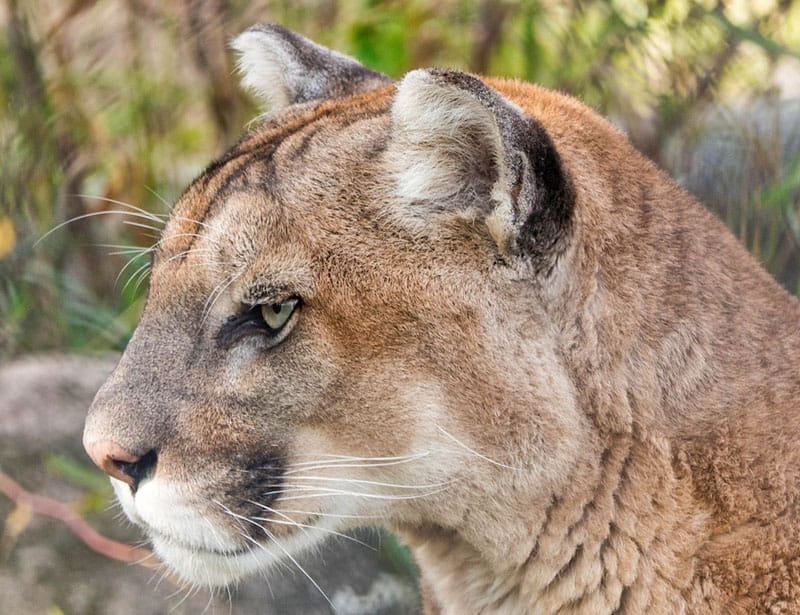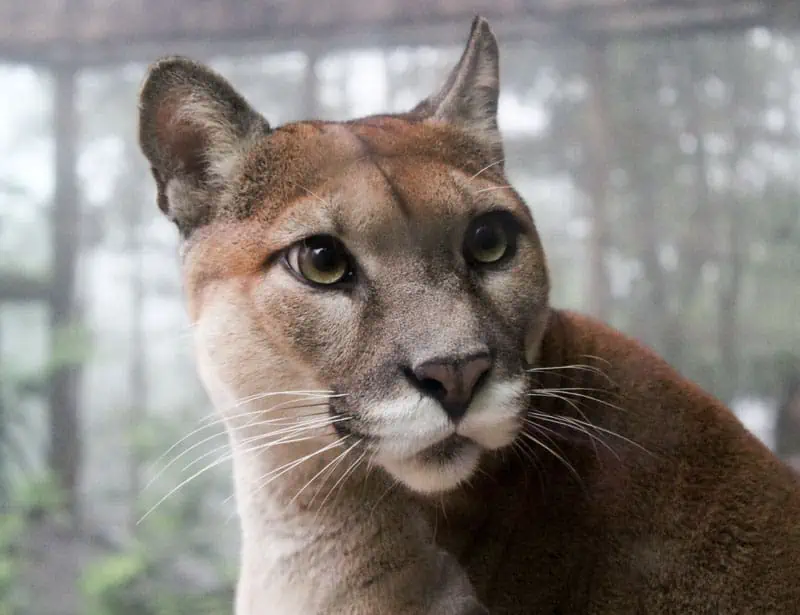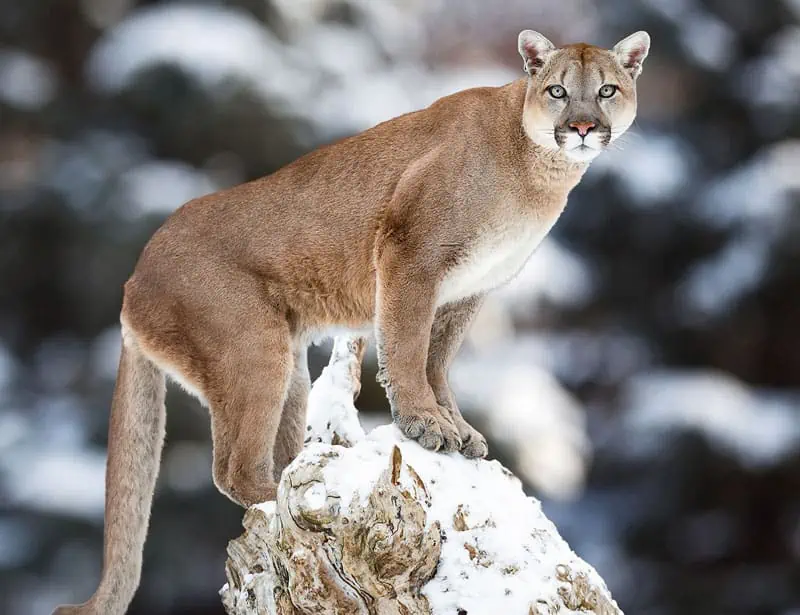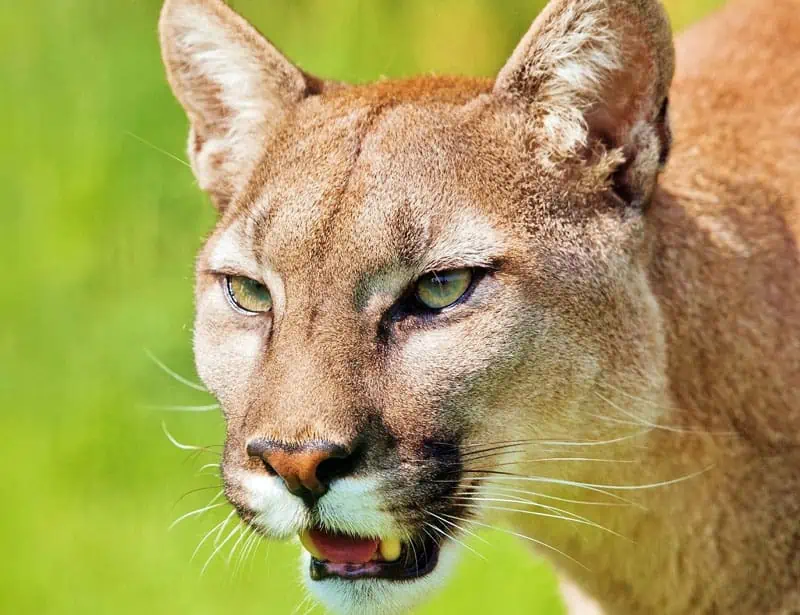10 Amazing Puma Facts About These Mountain Lions
The puma (Puma concolor), or "Guardian of the Andes," is a large cat that lives across the Americas, particularly in South America. It is also known as the cougar, mountain lion, or catamount. This list of puma facts covers their tremendous physical abilities, strength, agility, swimming, climbing skills, and more.
10 Puma Facts

1. Pumas are officially not big cats.
Believe it or not, pumas, also known as cougars or mountain lions, are not officially big cats despite their size (though they belong to the same big cat family.) Classification into the Panthera genus club, including lions, tigers, leopards, and jaguars, requires the ability to roar, thanks to a ligament in their larynx.
However, pumas do not possess this ligament, which makes them incapable of roaring. Instead, the genus Puma falls in the same group as the smaller feline species (Felidae) due to their quiet(er) demeanor.
2. Pumas lived through the Ice Age.

The puma was one of the few animals that survived the harsh environment during the Ice Age. Despite the extreme conditions and challenging terrains, these cats could adapt and navigate the glacial landscapes. The puma did not succumb to the harsh realities of the Ice Age and survived.
The puma was a bone accumulator during the Ice Age, transporting their kill back to their dens, resulting in sites littered with animal remains.
Archaeologists initially mistook these clusters for early human settlements due to their appearance. However, closer inspection revealed that pumas left unique marks on their prey's bones due to their large jaws and teeth. This discovery helped identify the actual owners of the sites.
3. Pumas are solitary cats.
Unlike other cats that live in groups, pumas are solitary creatures from an early age2. When they turn two years old, young pumas leave their mother's presence in search of their territories.
Moreover, pumas prefer to ambush their prey rather than engage in long chases, using stealth and the element of surprise to their advantage. Pumas are also territorial, asserting dominance through scratches and scent markings to avoid confrontations.
Male pumas claim significantly larger territories than females; interactions with other pumas are few and far between, reinforcing their preference for solitude.
Pumas avoid human contact and encounters with other animals, only coming together with other panthers to mate. Overall, the isolated nature of pumas influences everything from their survival strategies to their hunting techniques.
4. Puma whiskers are unique.

Next on our list of puma facts: A puma's whiskers, scientifically known as vibrissae, are implanted deeper in the skin than standard fur and are encased in a small pocket filled with blood that amplifies vibrations. This attribute helps them move with stealth and precision, even in the dark.
Moreover, its whiskers allow the animal to sense its surroundings. While hunting, these whiskers move independently, mapping the location of prey. The tactile sensation these whiskers provide is similar to our sense of touch, enabling the puma to deliver a precise bite even in complete darkness.
5. Pumas are extraordinary leapers.
Pumas can also jump up to 15 feet in the air, nearly five times their height, covering 40 feet across. Their hind legs, longer and larger than their front legs, make this athletic feat possible.
The aerial acrobatics of pumas allow them to navigate rough terrain and catch prey. They can leap up to 40 feet, using their muscular tails to maintain balance. Even young puma kittens can perform these leaps, suggesting agility is innate. Their precision enables pumas to time their landings and avoid threats.
6. Pumas are sneaky hunters.

During sunset, the puma emerges and begins the hunt, its russet coat blending with the surroundings. In the wilderness, this ambush predator seems to play a game of hide and seek with its prey, using every rustle of leaves to approach the target strategically.
The puma is a watchful predator that waits patiently in the undergrowth or perched high in a tree. Its eyes remain fixed on unsuspecting prey, biding its time while remaining hidden.
When the time is right, the puma pounces on its target, using its hind paws to leap from nowhere. The puma relies on precision rather than brute strength when hunting; it holds prey down with its sharp claws while biting its neck.
7. Pumas can purr.
The puma shares a physical trait with house cats. Specifically, the puma can purr, surprising given its reputation as a skilled predator. When standing in the wilderness, one might hear the soft purring of a puma. The puma's purring ability comes from the structure of its larynx and hyoid apparatus.
Unlike other big cats that roar, the puma's hyoid bone is solid and a single piece, preventing it from roaring. The puma's purr communicates tranquility, satisfaction, worry, or unease. Even puma cubs purr to communicate with their mothers.
8. Pumas observe unique reproductive habits.
During the mating season, pumas perform a week-long display of affection. Adult males rub against and nuzzle the female's neck. Moreover, the couple mates multiple times throughout the week.
Once the mating is successful, female pumas enter a gestation period of approximately 91 days, consistent with other large cats. The birth of puma cubs typically results in an average of two to four offspring, although the number can fluctuate from one to six. Moreover, puma cubs are born blind and entirely dependent, and their bodies have spots that hide them amid their rocky and forested habitats.
After giving birth, the mother puma becomes a nurturing mentor responsible for protecting and teaching her offspring to hunt and survive in the wild. She dedicates herself to this role until the cubs reach approximately two years of age, ready to test their skills in the wild.
9. Pumas don't see humans as prey.

Another interesting puma fact is that despite their abilities, pumas generally do not display aggression towards humans and will instead try to avoid them. This behavior likely results from their history of living alongside humans; avoiding confrontation has become a successful survival strategy.
Statistics say fewer than 100 puma attacks on humans were recorded in the last century. Furthermore, these attacks are primarily defensive rather than predatory; pumas attack only when the puma perceives a threat to itself or its offspring.
Moreover, pumas may exhibit atypical behavior when sick or hungry. However, such scenarios are exceptions. Pumas typically eat large prey like deer, elk, or smaller mammals, even when their habitats overlap with human settlements.
10. Pumas face various threats.
Puma species everywhere face various challenges in today's rapidly changing world. Although most of the species are of "Least Concern," according to the International Union for Conservation of Nature (IUCN) Red List, their population is decreasing.
Habitat loss where Pumas live, mainly in Central and South America, is the main factor behind the decline of puma populations1. As human settlements expand, pumas lose their territories, reducing their space to roam, resulting in more frequent puma and human encounters. These confrontations can have fatal consequences for humans and pumas.
For instance, pumas attempting to cross busy roads or highways within their territories often get hit by vehicles and die. Additionally, pumas might attack pets or livestock, often resulting in farmers or homeowners killing the predators in retaliation. Moreover, hunters poach pumas living in the wild for their thick fur coat.
Climate change also alters precipitation patterns, affecting the availability of prey and the suitability of their habitats. It also exposes them to diseases and parasites, further stressing their populations.
Reserved areas protect pumas where these big cats can thrive without human interference. Wildlife corridors also help pumas safely cross busy roads. Finally, awareness campaigns try to reduce human-puma conflicts while governments enforce laws regulating puma hunting.
Remember to share these fascinating puma facts on social media and tag us!
Related: To further explore the animal kingdom, check out some of the other animals that start with P.
| 1 | Dickson, B., Jenness, J., & Beier, P. (2012). Influence of vegetation, topography, and roads on cougar movement in southern California. Journal of Wildlife Management, 69 (1), 264-276. |
| 2 | Logan, K. A., & Sweanor, L. L. (2001). Desert puma: Evolutionary ecology and conservation of an enduring carnivore. Island Press. |
Mike is a degree-qualified researcher and writer passionate about increasing global awareness about climate change and encouraging people to act collectively in resolving these issues.
Fact Checked By:
Chinny Verana, BSc.

